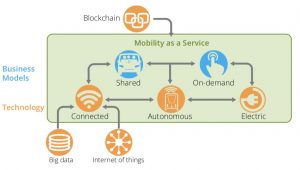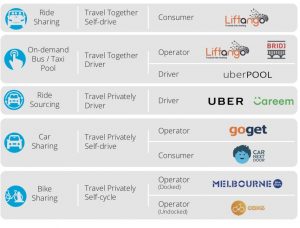 Future mobility will be cheap, door to door, personalised and ‘on demand’.
Future mobility will be cheap, door to door, personalised and ‘on demand’.
Transport will become a service that users can seamlessly access via a single interface that connects them to multiple modes of travel. The boundaries between private, shared and public transport delivery will be connected and the modes will be autonomous and electric. [1]
A vision for future mobility
Future mobility presents new business models for the way people get themselves from A to B. These include shared, on demand, and mobility as a service (MaaS) options. Often, future mobility models are supported by new mobility technologies, such as electric vehicles, autonomous vehicles, and micro-mobility options. that are supported by new technologies. Future mobility draws on a system of connectivity.
Below figure outlines the building blocks of future mobility: [2]
 Source: BCSD Australia (2018)
Source: BCSD Australia (2018)
How mobility is changing business
Mobility changes intersect multiple business levels, requiring new policies and procedures:
- Assets – future and existing, car parks, EV charging, asset locations, co-locations.
- Logistics – design, scale, collaboration with suppliers and supply chain technology.
- Procurement – legislative changes, changes to products procured.
- Sustainability – health, safety, reduced emissions, diversity access.
- Human Resources – flexible working, productivity, talent attraction, retention.
- Fleets – AV, EVs, car pooling, shared fleets, outsourcing, leasing needs, purchase costs.
Below table outlines future mobility transformation: [3]
From... Toward...
Individual car ownership as dominant form of transport Individual car ownership as part of multi-modal, on-demand, and shared transport
Limited consumer choice and few service levels More consumer choice and many service levels
Government-funded public transport Public and private transport operate in parallel
Unconnected, sub-optimal, transportation systems On-demand, connected systems that use data to unlock efficiencies
Sustainability Impact
Future mobility has the potential to improve the lives and livelihoods of billions of people.
Reports have shown that:
- transport accounts for 20% of global final energy consumption and 23% of global carbon emissions and has the fastest growing emissions of any sector [4]
- 70% to 84% of fuel energy is lost in engine and driveline inefficiencies [5]
- future mobility strategies need to be aligned with the Sustainable Development Goals (SDGs) to achieve its vision of providing safe, affordable, accessible, efficient, resilient mobility for all, while minimising carbon emissions and environmental impacts.
Even without a renewable energy source and including manufacturing, EVs result in reduced emissions compared to internal combustion engine (ICE) vehicles [6], at an average of 40% with a ‘typical’ UK energy mix.
- For businesses with the increased responsibility to account for Scope 3 emissions, this would include emissions from employees’ mobility arrangements to and from work.
- Businesses with fleets have an opportunity to reduce emissions through inclusion of future mobility options using on-demand, collaborative and alternate working arrangements.
Read more about how to account for vehicle emissions.
Shared and on-demand mobility services
Shared mobility
The mode of transport and/or users of transport can be a shared experience.
Shared mobility encompasses:
- carsharing
- bikesharing
- scooter sharing
- ridesharing (carpooling/ vanpooling)
- car park sharing
- shared freight mobility.
On-demand mobility
On-demand allows the user to select a mode via a dedicated platform with the ability to provide a first and last mile service between mass transport options.
Shared vs on-demand
Below figure shows a summary of different mobility modes: [7]
 Source: BCSD Australia (2018)
Source: BCSD Australia (2018)
Shared and on-demand mobility services have a set of key characteristics, [8] where they:
- provide mobile platforms to enter into a usage contract anytime, anywhere;
- include a social component allowing users to evaluate and share feedback of the service or mobility option;
- can easily customise transport to meet specific demands by both supplier and user;
- use real time data and are not dependent on fixed routes or infrastructure;
- benefit from a dense, mixed-use environment and;
- reduce the need for personal vehicles and parking spaces.
There are currently on demand public transport services operating or trialling in New South Wales, where consumers can request a vehicle to take them to the nearest transport hub. [9]
Mobility-as-a-Service (MaaS)
Mobility as a Service (MaaS) is the integration of various forms of transport services into a single mobility service accessible on demand. [10]
The intention of MaaS is to move away from asset owned transport (e.g. private car) to the use of transport as a service: [11] where users consume transport services (e.g. public transport). If public transport is supplemented by other mobility options, such as bike sharing, it becomes unnecessary for a person to own a vehicle.
For more information on MaaS, refer to the MaaS article.
Mobility technologies and enablers
Electric Vehicles (EVs)
EV’s electric and digital nature allows them to be better integrated to other mobility technologies, such as intelligent transport systems and vehicle automation. Already vehicle manufacturers have made strong commitments to electrify their fleets, this is evident through the $300 billion (USD) investments across global car brands. [12] Additionally, countries in all spheres of the globe have already begun banning petrol and diesel vehicles. [13]
Autonomous
Mass transit will be a clear benefactor of autonomous mobility, driverless trains/trams are already running on lines across Australia.
It is important to manage the rollout of autonomous vehicles to curb rather than add to traffic congestion through additional private autonomous cars driving on the road without passengers. It is also important to recognise that while automation can contribute to the connectivity of less densely populated areas, it should not be permitted to contribute to urban sprawl. [14]
Policy strategies such as occupancy-based pricing and new street design methodologies are critical to prevent increases in congestion. [15] Some notable examples of autonomous vehicles being trialled in Australia are trackless trams (ART) trials in Australian cities, [16] the Flinders Express (or ‘FLEX’) for first and last mile shuttle services as part of a five-year trial of autonomous vehicle technology set to encompass public roads in South Australia, [17] and RAC WA’s trials of driverless buses at its private Perth Airport facility. [18]
Connected vehicles
Connected vehicles can be used to improve vehicle safety, vehicle efficiency and commute times. The technology provides:
- real-time information about the surrounding traffic conditions
- traffic management decisions.
This information is expected to improve drivers’ efficiency, response, and comfort while enhancing safety and mobility. Connected vehicle technology can also further increase efficiency and reliability of autonomous vehicles. [19]

